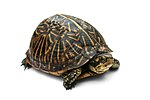Amniotes are tetrapod vertebrate animals belonging to the clade Amniota, a large group that comprises the vast majority of living terrestrial and semiaquatic...
48 KB (3,794 words) - 16:52, 20 September 2024
Reptiliomorpha (section Origin of amniotes)
Pan-Amniota) is a clade containing the amniotes and those tetrapods that share a more recent common ancestor with amniotes than with living amphibians (lissamphibians)...
28 KB (2,971 words) - 01:18, 19 August 2024
(/tɛˈtræpədə/). Tetrapods include all extant and extinct amphibians and amniotes, with the latter in turn evolving into two major clades, the sauropsids...
104 KB (10,592 words) - 16:33, 14 September 2024
advanced reptiliomorphs (transitional between "amphibians" sensu lato and amniotes) positioned close to, but outside of the clade Amniota, though some recent...
12 KB (1,207 words) - 17:10, 25 March 2024
Egg (section Amniote eggs and embryos)
Like amphibians, amniotes are air-breathing vertebrates, but they have complex eggs or embryos, including an amniotic membrane. Amniotes include reptiles...
42 KB (4,715 words) - 23:29, 22 August 2024
Sauropsida (Greek for "lizard faces") is a clade of amniotes, broadly equivalent to the class Reptilia, though typically used in a broader sense to also...
30 KB (2,759 words) - 05:08, 11 September 2024
advanced labyrinthodonts. The oldest known animal that may have been an amniote, a reptile rather than an amphibian, is Casineria (though it has also been...
30 KB (3,190 words) - 14:03, 10 September 2024
The primitive streak is a structure that forms in the early embryo in amniotes. In amphibians, the equivalent structure is the blastopore. During early...
23 KB (2,803 words) - 21:33, 7 April 2024
Others prioritize the clade Sauropsida, which typically refers to all amniotes more closely related to modern reptiles than to mammals. The earliest known...
138 KB (14,817 words) - 01:33, 21 September 2024
conditions. Amniotes, however, prospered due to specific key adaptations. One of the greatest evolutionary innovations of the Carboniferous was the amniote egg...
14 KB (1,149 words) - 04:52, 11 August 2024
lay their eggs in aquatic environments. They are distinguished from the amniotes (reptiles, birds and mammals), which can reproduce on dry land either by...
6 KB (606 words) - 02:26, 10 April 2024
animal groups that have adapted to life in dry environments; the other is amniotes, whose living members are reptiles, birds and mammals. Both the smallest...
131 KB (12,443 words) - 00:04, 21 September 2024
fluid is the protective liquid contained by the amniotic sac of a gravid amniote. This fluid serves as a cushion for the growing fetus, but also serves...
16 KB (1,928 words) - 21:38, 1 September 2024
sense, it is a paraphyletic group encompassing all tetrapods excluding the amniotes (tetrapods with an amniotic membrane, such as modern reptiles, birds and...
161 KB (18,019 words) - 16:48, 6 September 2024
PMID 23653398. Laurin, M.; Reisz, R.R. (1995). "A reevaluation of early amniote phylogeny". Zoological Journal of the Linnean Society. 113 (2): 165–223...
27 KB (636 words) - 00:35, 1 September 2024
VP359229.2 and FMNH PR 1031. It is a member of the Molgophidae, a lineage of amniote-like tetrapods which exhibited a pattern of body elongation and digit reduction...
2 KB (183 words) - 20:27, 6 April 2024
Serpentes (/sɜːrˈpɛntiːz/). Like all other squamates, snakes are ectothermic, amniote vertebrates covered in overlapping scales. Many species of snakes have...
151 KB (15,128 words) - 10:08, 27 August 2024
the only group that survived into the Cenozoic are mammals. Unlike other amniotes, synapsids have a single temporal fenestra, an opening low in the skull...
57 KB (5,746 words) - 18:11, 20 September 2024
snake in the Harry Potter series Nagini mazonense, an extinct species of amniote Nagin (disambiguation) Nagina (disambiguation) Naga (disambiguation) Ichchadhari...
782 bytes (130 words) - 04:03, 15 July 2024
amphibians to evolve into amniotes that had adaptations that allowed them to live farther away from water bodies. These amniotes began to evolve both carnivory...
20 KB (2,004 words) - 11:17, 4 September 2024
(lissamphibians, as well as the extinct temnospondyls and lepospondyls) Amniotes or true land vertebrates Sauropsids (reptiles and birds, as well as the...
78 KB (7,094 words) - 14:43, 20 August 2024
gametes was achieved through the transition to internal fertilization. Among amniotes, the development of an erectile penis occurred independently for mammals...
43 KB (4,043 words) - 01:45, 18 September 2024
bird to have ever lived, with their eggs being the largest known for any amniote. Elephant birds are palaeognaths (whose flightless representatives are...
34 KB (3,426 words) - 06:04, 9 September 2024
sac-like structure filled with clear fluid that forms part of a developing amniote's conceptus (which consists of all embryonic and extraembryonic tissues)...
8 KB (873 words) - 16:19, 17 August 2024
and mammals) are descended from one branch of reptiliomorphs, the amniotes. Amniotes achieved dominance, while all other reptiliomorphs and most batrachomorphs...
8 KB (897 words) - 13:37, 1 May 2024
islands and, in the case of sea turtles, much of the ocean. Like other amniotes (reptiles, birds, and mammals) they breathe air and do not lay eggs underwater...
126 KB (13,111 words) - 12:38, 22 August 2024
which became dominant land vertebrates, as well as the first appearance of amniotes including synapsids (the clade to which modern mammals belong) and sauropsids...
110 KB (11,562 words) - 22:36, 17 September 2024
Temporal fenestrae are openings in the temporal region of the skull of some amniotes, behind the orbit (eye socket). These openings have historically been used...
6 KB (602 words) - 10:54, 27 January 2024
a cloaca, which is thought to be a feature inherited from the earliest amniotes. Marsupials have a single orifice for excreting both solids and liquids...
7 KB (696 words) - 00:14, 31 August 2024




























